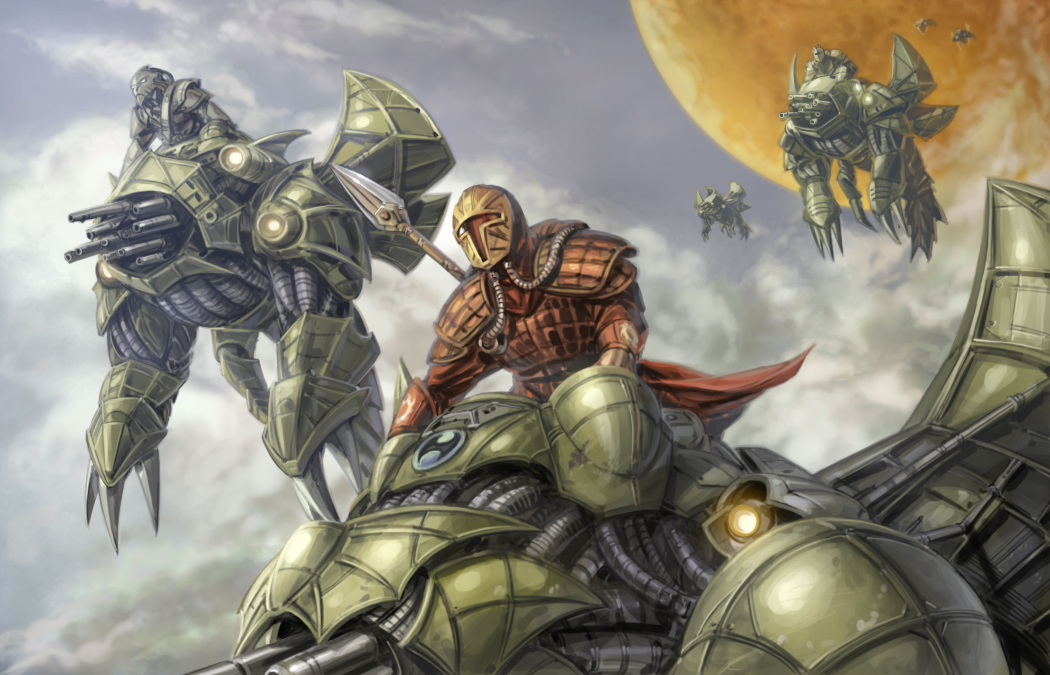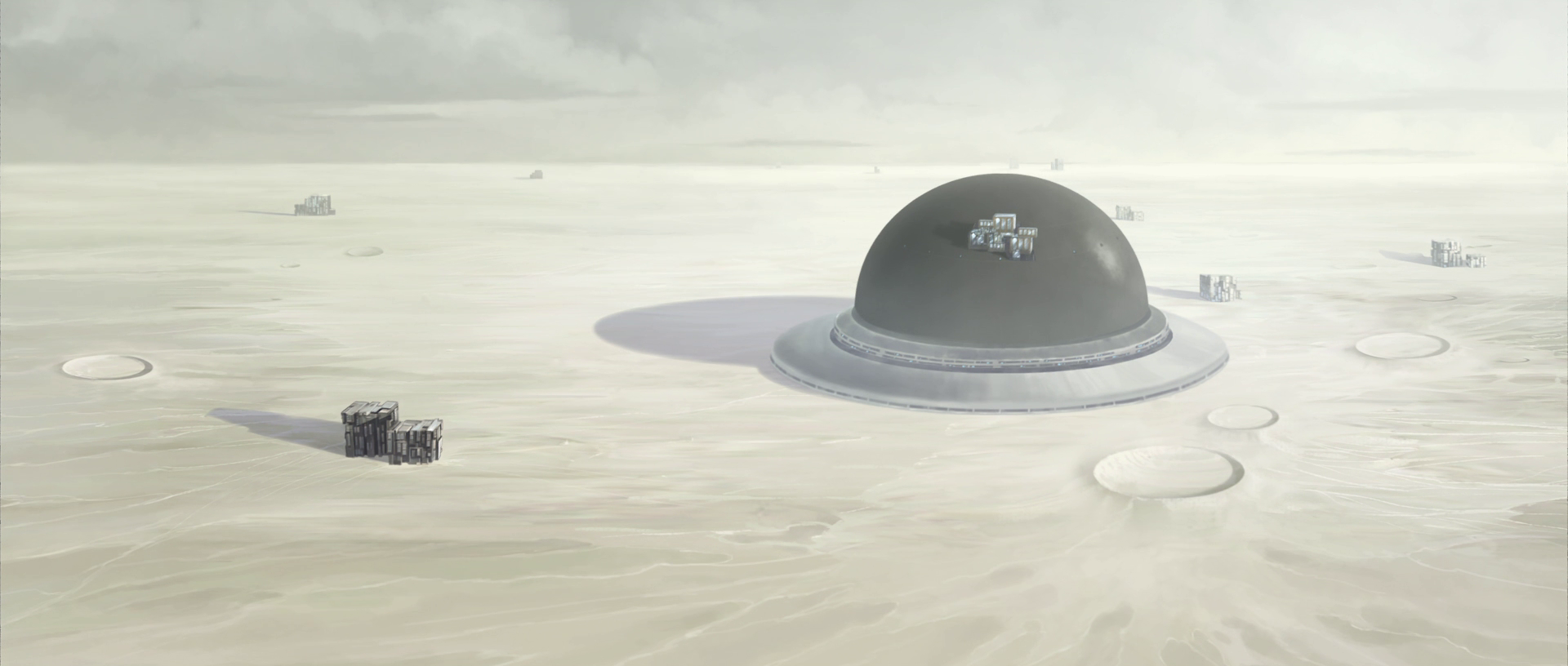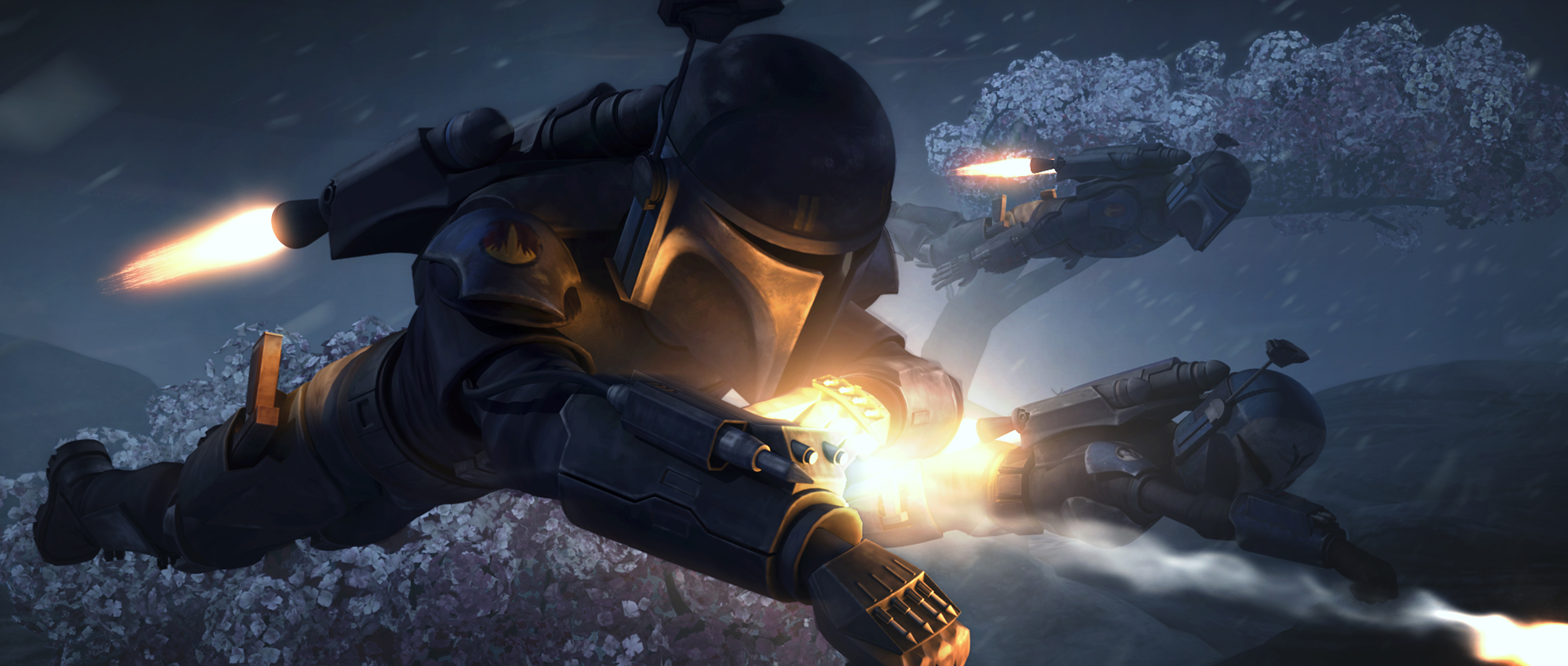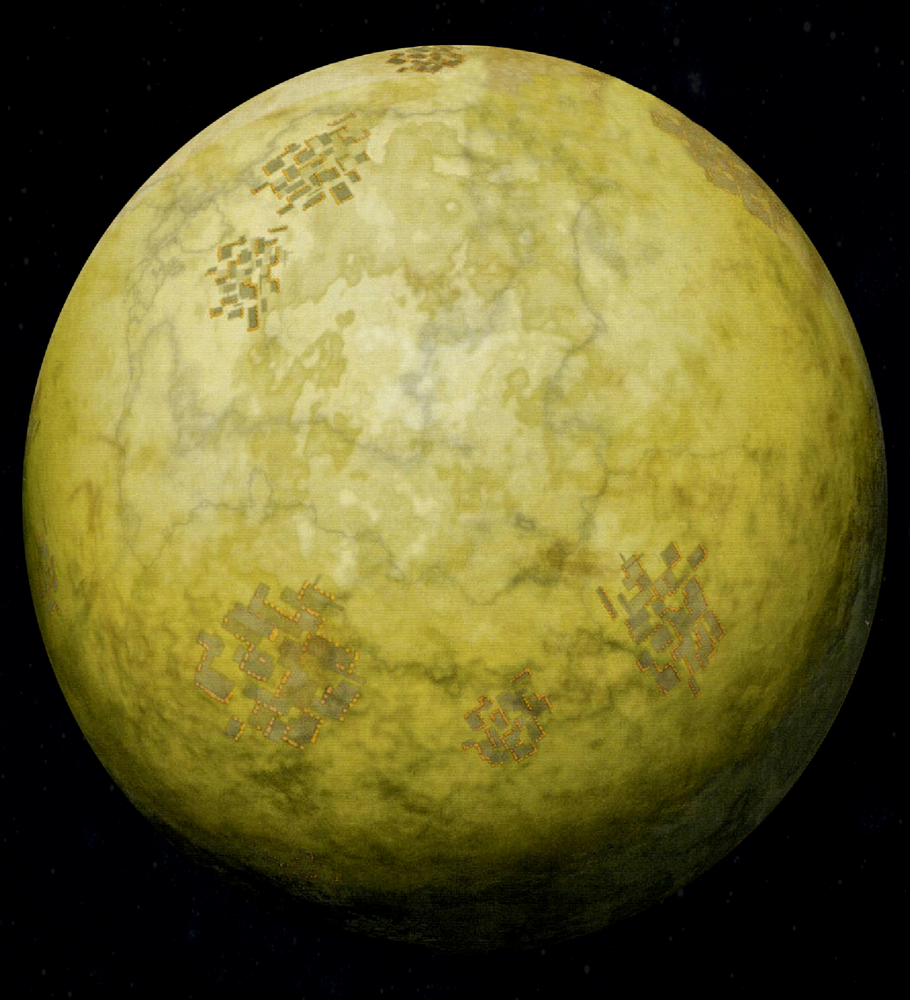The Mandalorian Excision of 738 BBY—known to Mandalorian natives as the Dral'Han, or the Annihilation—was a brief but brutal conflict that saw the devastation of Mandalorian Space at the hands of the Galactic Republic. Following the Republic's enactment of the Ruusan Reformations in 1000 BBY, the Mandalorian people experienced a growth in technological prowess and military power, but they refused to join the Republic due to their traditional warrior ways. Alarmed by the rising threat of the Mandalorians, the Jedi Order organized the Republic's Judicial Forces and Planetary Security Forces in a preemptive strike on Mandalorian Space. The Mandalorians had no hope of winning a war against the Republic and suffered greatly in the resulting battles, with a number of planets including Fenel, Ordo, Concord Dawn, and Mandalore itself crippled by bombardment. The damage lasted for centuries, with entire sections of Mandalorian worlds remaining barren deserts.
Following the Excision, the Republic disarmed and occupied Mandalorian Space, installing a provisional government to oversee sectoral affairs. The Mandalorians preserved their distinctive culture, as well as their resentment of the Republic and the Jedi who had defeated them, while rebuilding the worlds that the war had left scarred. The Excision led to the formation of the pacifistic New Mandalorians, who prevailed over the warrior clans in many areas of governmental operation and society, becoming the new rulers of Mandalore. Nevertheless, many unrepentant warriors continued their traditional practices, eventually leading to the formation of such splinter groups as the Death Watch. The schism in ideology ensured that further conflict would ensue, as it did well into the time of the Clone Wars.

The Mandalorian warrior clans long nursed a hatred of the Republic and the Jedi Order.
In the last millennia of the regime of the Galactic Republic, the Mandalorian warrior people of Mandalorian Space clashed with the Republic on numerous occasions, most notably in the Mandalorian Wars from 3976 BBY to 3960 BBY. After losing their leader, Mandalore the Ultimate, the Mandalorian warrior clans were disarmed and surrendered to the Republic, though they were left with a simmering resentment of the Republic and the Jedi Order that had defeated them. The Mandalorian warrior codes came to be followed only in Mandalorian Space, but it was not until the emergence of a new leader, Mandalore the Uniter, in 1051 BBY that the Mandalorians began to reclaim stability in their lawless area of the galaxy. In a movement known as the Return, Mandalore the Uniter urged his fragmented people to strengthen and defend Mandalorian Space. They were thus able to survive the millennium-long New Sith Wars and grew to be a regional industrial power, safeguarding neighboring sectors and star systems from trouble while also advancing in technology and military strength. It was during this time that Mandalorian Space, primarily the Mandalorian homeworld of Mandalore, reached an apex in its military power.
As Mandalorian Space returned to galactic prominence as a rigidly disciplined society, the Republic, left weakened and splintered after the New Sith Wars, began to draw itself back together following the Ruusan Reformations of 1000 BBY. The Republic's re-institutionalization of the Outer Rim Territories thus reopened conflict with Mandalorian Space. Although first seen as a much-needed source of stability, the Mandalorians—who had begun to tax commerce along the Hydian Way, were forcing economic and defense pacts onto bordering sectors, and disregarded the Republic's new defense force restrictions altogether—re-emerged as a threat to the Republic. Some pro-peace clan leaders believed that Mandalorian Space should join the Republic as one of its most powerful and influential sectors, as they had no chance of winning a direct engagement with the Republic. Nevertheless, the Mandalorians' overall position was resoundingly for continued independence, as popular opinion held that non-warrior Mandalorians could not claim to be Mandalorians at all. That mindset prevailed for several centuries, until the Republic and the Jedi Order decided to move preemptively against the ever-resistant Mandalorians.

Key worlds such as Mandalore were exposed to fierce Republic bombardment.
In the year 738 BBY, the Republic authorized the creation of a task force to remove the threat of the Mandalorians as an opposing power. The Republic's Judicial Forces were called in alongside units from various Planetary Security Forces of the Expansion Region, with members of the Jedi Order serving as commanders for the war effort. The Jedi led their troops to Mandalorian Space, striking at key Mandalorian worlds such as Fenel, Ordo, and Concord Dawn, as well as Mandalore itself. In the battles that followed, Republic warships exposed the targeted planets of Mandalorian Space to devastating bombardment, creating barren deserts of white sand from entire regions of the planetary surfaces, including forests and farmland. Having lacked from the start any hope of repelling a Republic attack, the Mandalorian clans were defeated, and the Jedi–Republic forces claimed victory. Many Mandalorian warriors were exiled, disarmed, or killed as a result of the conflict.

The New Mandalorians emerged following the Excision, espousing peace to save their world.
The Mandalorian Excision, the Republic's name for the short but brutal war, left Mandalorian Space crippled. Mandalorian natives remembered the conflict as the Dral'Han, translated from Mando'a as "the Annihilation." In a move that would last for decades, the Republic occupied and disarmed Mandalorian Space, establishing a loyal caretaker government for the sector from remnants of the pro-Republic peace movement from before the war. The occupation of Mandalore birthed a schism in ideology within Mandalorian society: In opposition to the warrior clans rose the pacifistic New Mandalorians from the caretaker government. Resenting the Republic but seeing no benefit to continued opposition, the New Mandalorians renounced the ages-old warrior codes for nonviolence and neutrality in an effort to save their ravaged homeworld.
The New Mandalorians triumphed over the warrior clans, holding most positions of power and gaining rule of Mandalorian Space, due to the fact that the majority of Mandalorians were weary of war. Nevertheless, the societal rift in ideology shaped the following centuries of Mandalorian history. Those who continued to practice the outlawed warrior ways in secret became known as the Faithful, while the New Mandalorians were termed the Faithless. None of the Mandalorian clans escaped the enduring divisions between the so-called Faithful and Faithless.
The devastation to Mandalore and other worlds lasted far beyond the Excision, with the desolation in many areas remaining well into the time of the Galactic Empire. In spite of the scars to their homes, the Mandalorians retained their distinctive culture and style of technology. Since the white sand deserts of Mandalore were uninhabitable, the New Mandalorians who remade their world engineered massive bio-cube cities as part of their new civilization. Their domed capital, Sundari, was one such city that was erected amidst the inhospitable sands.
For the Republic, the Excision brought into question the best methods for coordinating various units of the Planetary Security Forces, an endeavor that the Republic's war effort had necessitated. Following the Excision, various Republic marshals and admirals met at the Corsin Retreat to deliberate on the subject, leading to the revival of the Republic Naval College as the College of Planetary Security Forces on Anaxes.

Divisions among the Mandalorian Faithful led to the creation of factions like the Death Watch.
As Mandalore was rebuilt as an industrial power over the next few centuries, a number of unrepentant warriors and mercenaries were exiled to the moon Concordia. Others kept to the regions of Mandalore that were unspoiled by war like the traditional capital of Keldabe, or ventured out into the galaxy to become bounty hunters like their ancestors. The following generations of the Faithful soon encountered further divisions, with a reformist movement known as the True Mandalorians coming into conflict with the Death Watch, a splinter group of terrorist radicals, in 60 BBY. The ensuing Mandalorian Civil War ended with the decimation of the True Mandalorians in 44 BBY, while the Death Watch survived and later initiated an attempt to overthrow the New Mandalorians. The result was the Great Clan Wars, a bloody civil war that killed a great number of Mandalorians and exacerbated the devastation to Mandalore that the Excision had originally wrought. Though defeated, the Death Watch leader Tor Vizsla survived the upheaval, and he wrote about the Annihilation in his Death Watch manifesto Ba'jurne Kyr'tsad Mando'ad.
The New Mandalorians remained in power following the Great Clan Wars, much to the chagrin of the Death Watch, which allied itself with the Confederacy of Independent Systems during the Clone Wars of 22 BBY to 19 BBY. In doing so, the Death Watch hoped to finally overthrow the New Mandalorians and exact revenge upon the Republic for its savagery during the Excision. By that time, the New Mandalorians won representation in the Galactic Senate for the so-called "New Mandalore." The neutrality of Mandalore continued from the post-Excision era well into the Clone Wars thanks to the efforts of Duchess Satine Kryze, who emerged as the leader of the New Mandalorians at that time. In spite of hindrances by the Death Watch and the Confederacy, Kryze was able to preserve the political isolation of the Mandalore system in the war while remaining loyal to the Republic.
Yet, the warrior ways ultimately won out over pacifism, with both the Death Watch and New Mandalorians suffering critical losses from further infighting, and the Mandalorian Protectors rising to power under the leadership of a new Mandalore, Spar. Decades later, the Mandalorian Excision was one of the chapters of Mandalorian history that the historian Vilnau Teupt documented in his 24 ABY keynote address at the Brentaal Academy.

The retconned Mandalore, ravaged by the Mandalorian Excision
The Mandalorian Excision, created as a backstory for a 2010 second season story arc of the Star Wars: The Clone Wars television series, represented a retcon in the history of the planet Mandalore in the Expanded Universe. Mandalore was a prominent location in author Karen Traviss's Republic Commando novel series from 2007 on, which portrayed it as a more arboreal world. When the Mandalorians were to be explored in the Star Wars: The Clone Wars television series, the backstory for Mandalore—created by crew members such as Series Supervising Director Dave Filoni with input from Series Producer George Lucas—was that the world had been devastated to the point that its surface had been laid to waste. That destruction had led to the formation of the pacifistic New Mandalorians, who were featured as part of the second season storyline.
Beginning in August 2009 with The Essential Atlas, reference material reflected the change in canon. The Essential Atlas introduced a conflict between the Mandalorians and the Jedi as the reason for the devastated Mandalore, whose barren surface was portrayed in the series. Co-authors Jason Fry and Daniel Wallace did not learn about the series' retcon of Mandalore until they were almost finished with The Essential Atlas, so Fry worked quickly with Pablo Hidalgo and Leland Chee of Lucasfilm Ltd. to integrate the new information, particularly with the Jedi–Mandalorian conflict. Fry was later able to explore the details of the event in The Essential Guide to Warfare, published in April 2012. He named the event the "Mandalorian Excision" as a clear message of the Republic's cold treatment of Mandalore to ensure Mandalorian resentment.
The Bounty Hunter Code: From the Files of Boba Fett, released in 2013, was the first publication to visually depict the Excision. It also went into further detail about the event's aftermath and legacy via an in-universe narrative allegedly authored by Tor Vizsla.
- The Essential Atlas
- Star Wars: The Clone Wars: New Battlefronts: The Visual Guide
- Star Wars: The Clone Wars Official Episode Guide Series 1 & 2
- Star Wars: The Clone Wars: Incredible Vehicles
- The Essential Guide to Warfare
- Star Wars: The Ultimate Visual Guide: Updated and Expanded
- The Bounty Hunter Code: From the Files of Boba Fett